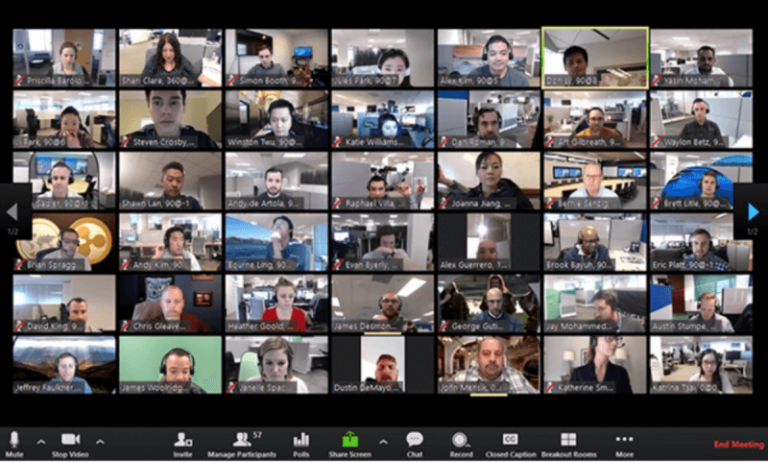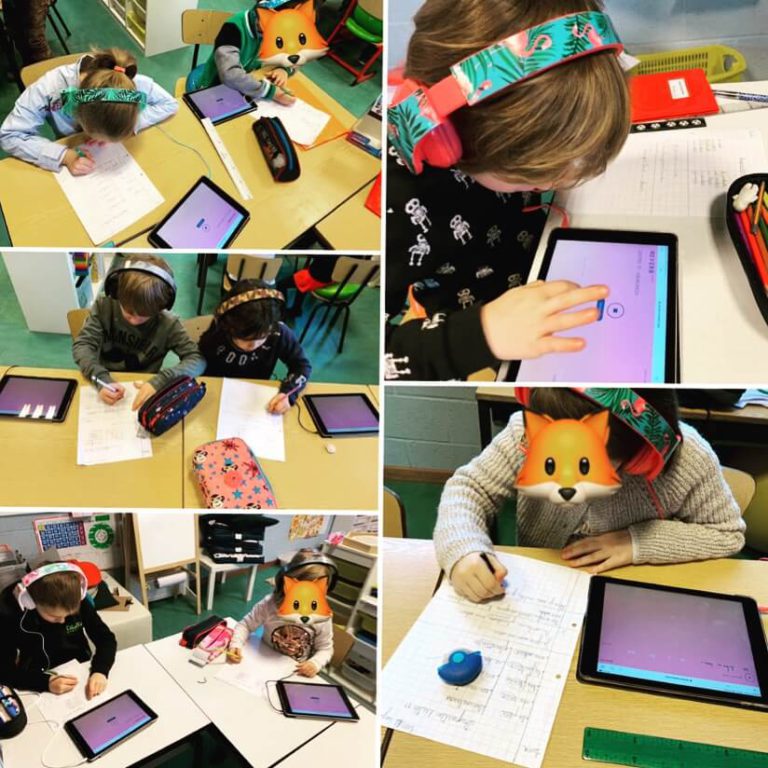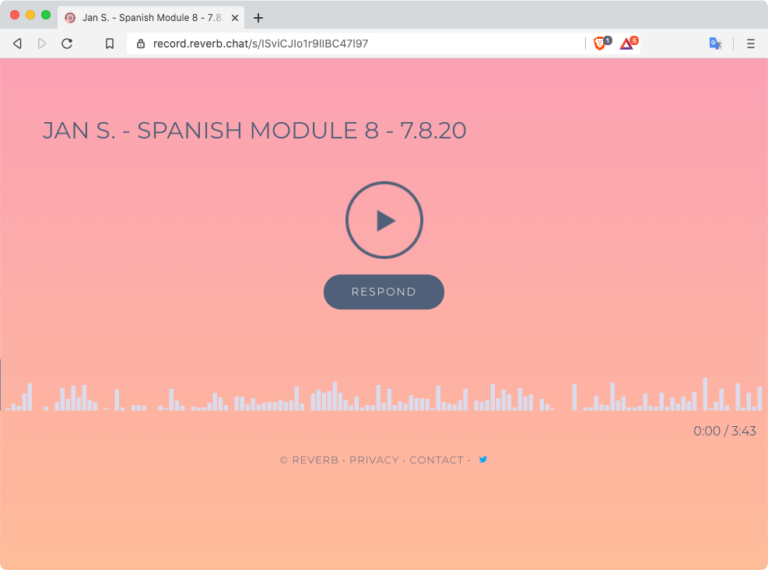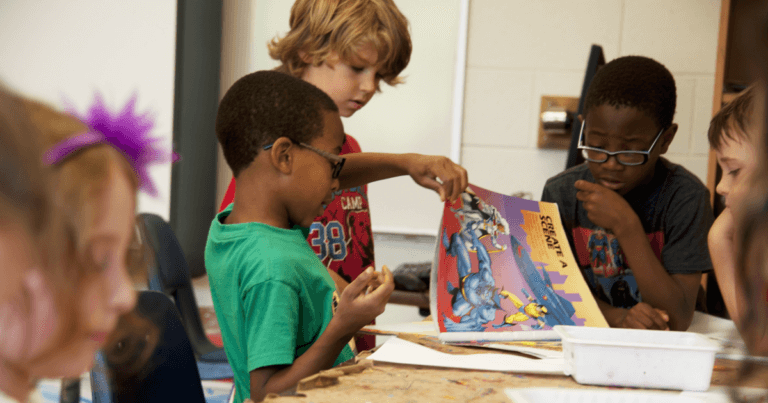The ethos of Bluetooth headphones and voice assistants have taken over homes, streets, and offices, and is now moving into classrooms. Audio is the next big wave to hit education, solving the ever-increasing problem of distance, both physical and emotional, between learners and teachers.
Prosumer tools can be used, as can standard LMSs (learning management systems). There are free tools abound (like this one) to record from a computer, from a tablet, or from a phone; and with cloud-based virtual classrooms, sharing couldn’t be easier. Special hardware is not needed!
With insights and perspectives from five accredited education professionals – teachers, mentors, leaders, influencers, and education business owners – this article will show you how students are learning more effectively in and out of the classroom using audio.
We’ll look at real-time audio vs. asynchronous audio, learning by speaking vs. learning by listening, and considerations that every teacher should make in giving students the best auditory experience possible.
What’s in this article:
- The difference between synchronous and asynchronous audio in education.
- The importance of audio media in teaching.
- How to use audio and voice technology in the physical classroom.
- Utilizing audio technology with remote and virtual classrooms.
- How to use audio in blended learning.
- Recording, speaking, listening, and comprehending to increase SEL (social/emotional learning).
- Best practices for audio in language training.
- Getting started.
Synchronous (real-time) vs. asynchronous audio
When it comes to audio in learning, especially interactive audio, there are two forms of audio communication to understand:
Synchronous audio communication
- Real-time.
- Examples include in-person speaking, meetings and conferences, phone calls, or any call with audio, walkie talkie software, and live Q&A.
Asynchronous audio communication
- Participants can go at their own pace.
- Examples include audio/voice notes, voice messages through chat apps such as Whatsapp or iMessage, and threaded voice communication for assignments, courses, and questions.
The concept of asynchronous voice communication usually throws people off at first, but really it sounds a lot more complicated than it actually is, as hopefully, the above examples demonstrate.
If you’re still confused, here’s another example – if you’re a French teacher, and a student emails you some spoken French practice, and you email back some spoken feedback, that would be asynchronous voice communication. It’s that easy.

Importance of audio media in teaching
Audio in education doesn’t always have to be direct person-to-person(s) communication, however.
Teachers often use instructive and informative audio media such as podcasts, book narrations, and audio tracks in videos and movies.
Students can stop the lessons, start over, and listen through difficult sections without peer pressure.
Wanda Kay Knight is a literature instructor and children’s writer but uses several forms of audio media when she teaches. She advises, “Incorporating auditory lessons into the school curriculum dramatically enhances enjoyment and retention for students.”
In one example, Wanda describes how she uses book narration to teach reading to younger grades. “Simply put headphones on each student and allow them to listen to a book while reading along with their own copy.”
Wanda explains the benefits of this method, “Students in a classroom learn reading at their own pace (this is not the status quo). There is no rushing. Students can stop the lessons, start over, and reread and listen through difficult sections without peer pressure.”
What if you’re the one actually creating the audio media though? Erick Prospero is the founder of Ninja Tropic, one of the largest eLearning animation studios in the world, and speaks on how to properly design educational audio.
He says, “We can’t assume everyone is in a quiet room with headphones on. Sound effects and music certainly make audio more engaging, but oftentimes it’s best to stay on the safe side in terms of reducing distraction… Remember that audio is used to boost memory and is responsible for guiding the experience of a learner.”
Audio in the physical classroom
From helping young students learn to read, to watching movies in different languages, to lectures, and to recording of vocabulary, the applications of audio in a classroom are seemingly endless, as are the benefits.
Every student is different and what works for one student may not work for another. This is where audio in a classroom comes into play.
For some students, listening (auditory learning) is critical; it gives them a vastly better understanding than reading.
Karen Gross is the former President of Southern Vermont College and is now a DC-based advisor to non-profit schools, organizations, and governments.
“I want to emphasize that students learn differently. For some students, listening (auditory learning) is critical; it gives them a vastly better understanding than reading. So, students need to know their own learning styles and teachers recognize the need to teach to all types of learners,” Karen says.
She recommends an in-person SEL (social and emotional learning) exercise to monitor and hone students’ listening abilities, especially when it comes to contextualization.
- Read a short and complex passage to your students. No more than 50 words.
- Now ask them to write one word they heard, but did not understand. Do not tell them before the exercise this will be asked of them. You want students not to focus on what they don’t understand. Give special attention to students who look like they’re having a hard time.
- Read the passage again.
- Explain the words students didn’t understand, using examples. Share how context can provide meaning even if one does not know the specific definition of a word.
- Next read something in a language with a Latin base, such as French, Italian, or Spanish. Make sure it is short. Read it with expression.
- Ask students what is now being discussed; this time they should have listened to tone, word roots, and feeling.
Karen adds of the steps in this exercise, “These are all learning skills and it is remarkable what students can understand just from listening well and carefully.”

Of course, it’s also essential to consider the acoustics of a classroom when doing any listening exercise or giving a lecture. Shy students shouldn’t have to suffer, so remember to take considerations for those in the back of the classroom. This could mean setting up a microphone and speaker if it’s a lecture hall, or just simply walking around the room and looking for students who appear confused.
Confused students can be addressed then and there so they can follow along, or sent a voice note summary afterward so they know what they missed.
Audio for remote and virtual classrooms
Teaching in person, for many, is challenging enough, and the digital divide, if not done properly, can substantially vitiate lessons being taught.
In an online environment, auditory lessons become near to essential.
The first thing to note is that with distance learning, in a virtual classroom, text-based learning without media will only get through to the most motivated learners. With younger students, this becomes even more so the case.
We live in a media-driven world. Reading has consistently trended downwards year over year since the early 2000s. According to the numbers, students read less and enjoy reading less now than ever before.
Accessibility to audio and video on the Internet has saturated attention spans. Students are less used to text than in the past, and more used to media they can hear and watch.

What students respond to has changed and in distance learning scenarios where a teacher isn’t physically present, students should be given content that plays most to their attention.
“In an online environment, auditory lessons become near to essential,” says Wanda Kay Knight.
“When teachers speak in the background, whether it be while showing PowerPoint slides or pictures, or as they show themselves working out math problems on a digital board, the student is able to have a more realistic classroom situation.”
In order to maximize engagement, teachers should be incorporating asynchronous and synchronous voice communication. Students and teachers alike may not always want to show their faces, or even be able to, and voice is an easy solution.
Teachers can quickly send asynchronous voice messages to students and parents and have synchronous 1-on-1 voice conversations over the web. Asynchronous can be used for students to watch and listen to lectures on their own time, and synchronous can be used for students to seek real-time answers.
Just as they are with listening, students are also more used to speaking now than in the past. In the mid-2010s, voice notes were incorporated into popular messengers like iMessage, WhatsApp, and WeChat, and digital-first generations especially have been sharing their voice since.
Too many teachers simply rely on writing.
In a distance learning scenario, speaking should be used in a variety of ways. A great example of this is with vocabulary training, where the interactivity of audio exercises leads to increased retention.
With over a decade experience in the ESL industry, Quincy Smith is the founder of ESL Authority, one of the top-ranking English as a second language (ESL) companies.
Quincy explains how instructors should use asynchronous audio when teaching vocabulary in a distributed setting.
“Anytime you have a vocabulary component in a lesson, we like to have teachers give access to a file where they repeat the word or phrase and then use it in 3-5 sentences. Then, as part of an assignment, teachers should have the students do the same – too many teachers simply rely on writing,” Quincy recommends.
He continues, “Adding this audio element helps students become better verbal communicators and commit vocabulary to memory.”
Along these lines is the trend of experiential final exams. In one example, teenage physics students had conversations with the elderly, teaching them about physics. This caused lessons to be much more memorable than with a standard final exam.
With remote learning and audio, it’s also especially important to take class size into consideration. Synchronous audio with large class sizes can present several issues. Students could constantly talk over each other and confused tones of voice may be harder to discern for even the most adept teachers.
In instances such as this, asynchronous voice is necessary for presenting lessons, receiving audio answers, and giving feedback.
Using asynchronous audio in a virtual classroom, teachers give students a small class feeling; instructors discern levels of understanding from individual students, even when the class is large.
Audio for blended learning
In a blended learning scenario, where students learn both online and in-person, audio becomes an extension of the classroom and is valuable for enhancing physical lessons.
In addition to the techniques presented above (sending informative voice notes to confused students, exercises, and remote audio assignments for large classes), teachers should be making the most out of blended learning with audio media, communication between faculty, and communication with parents.
Kat Sorbello created ‘The Stella Way,’ a framework for developing engaging blended and remote courses, which she has been producing for clients since 2009.
“Audio in education is useful to share immediate feedback and to supplement written instructions,” She says. “It is extremely beneficial for auditory learners who can easily be distracted by visuals or for busy learners who want to learn on the go, such as with podcasts.”
She says audio lessons make for a substantial way to impart knowledge and gives an example of recording an interview to use in a course. “This interview was then used as a podcast for the final lesson in one of my modules.”
She adds of audio’s innumerable uses, “I find voice effective in the summary of a session, where students have had opportunities to understand content, and then demonstrate their interpretation and application of it.”

Audio can also be used between faculty and with guardians.
An easy way to incorporate audio into blended learning is to share students’ recorded answers or presentations with other faculty. Together, faculty, especially ones who share students, can discuss the best ways to get through to anybody struggling.
The student audio can additionally be shared with guardians via email or portals to discuss if there’s something at home that may affect learner success.
Aside from this, faculty should use asynchronous voice to share announcements with different cohorts, such as classes, grades, teachers, parents, or an entire school. Announcements can be listened to while walking to class, and with automatic transcription on voice, those without immediate access to headphones or a speaker can still read along.
Recording, speaking, listening, and comprehending
The importance of teaching active listening, comprehension, and clear speaking can’t be overstated in any classroom setting.
If we can help students enhance their listening skills, they will be better employees, better leaders, better partners, better friends, and better problem solvers.
In completely remote learning, and even in blended, emphasis on communication takes center stage. It’s much easier to practice SEL skills when everybody is in the same room. When students are separated by distance, this becomes difficult.
It’s crucial these skills don’t get neglected no matter the classroom setting. Knowledge means much less without proficient communication as so much of anybody’s life, at any age, involves convincing others. Part of convincing is being a good listener, and “Listening is a learned skill,” says Karen Gross.
“Listening well is a gift and if we can help students enhance their listening skills, they will be better employees, better leaders, better partners, better friends, and better problem solvers,” she says.
Listening, and learning to act on what you hear, is part of why you go to school. For many students, it’s important that learning has a career or relationship payoff, rather than only a philosophical one.
Karen’s 6 step contextualization exercise is fantastic for developing listening abilities, and there’s even more that can be done.
Kat Sorbello advises on this, saying, “I use virtual audio sessions to set up a situation promoting listening skills. Eliminating body language encourages students to focus only on what is being communicated verbally, resulting in students successfully expressing thoughts without leaving anything up to interpretation.” Exercises such as this can also be done in person, with listeners having their backs turned to the speaker.
It’s not enough to read and write; students need to listen and they need to speak. They need to speak synchronously, through digital conferences or face-to-face; and they need to speak asynchronously, through voice notes, reports, and answers.
Cloud-based speaking solutions are best for active classrooms, virtual and physical, because these solutions require the lowest learning curve. Voice can be shared right then and there, through an application or web browser, and there’s no downloading or uploading necessary for either party.
Voice is also much lighter-weight than video and takes less time to load and save. This is especially important for those who have slow connections. All this adds up to enhance the benefits of audio in an education setting.
Audio in language training
Quincy Smith already spoke on how 3-5 times audio repetition and examples are important for vocabulary retention, but he also advises on the added benefits of asynchronous recording. “Getting students to record themselves when learning a language is great for both measuring progress and correcting mistakes,” he says.
Students can listen to errors they’re making, instructors can analyze recordings to give tailored feedback, and both can go back to previous recordings to hear how comprehension and fluency has increased over time.

Speaking and listening should, of course, both be practiced heavily and Wanda Kay Knight suggests an effortless way to incorporate listening to audio media into a foreign language curriculum.
“At one point I was asked to fill in and instruct a Spanish class. We used various listening methods, but I found one to be particularly helpful. On Fridays, I would play a simple movie to my students,” she says.
She continues, “Usually, this was a cartoon or some other Spanish video. I left it playing in Spanish while using English subtitles. I found that by doing this, the students were more able to pick up the cadence of the language and learn to ‘hear’ how it flowed.”
Wanda expounds on the advantages, “Students were able to better discern between words and thought the foreign videos quite immersive. It was also fun when combined with some popcorn!”
Get started!
All these methods only scratch the surface to how deep the benefits of audio in education go. There are untold more techniques, and new ones are constantly emerging with modern technology.
In and out of the classroom speaking and listening should be done, at all points of education. You can start now with your favorite learning management system, or use software made specifically for communication in learning.
In an ever more connected world, you no longer need to be in the same location as your students, and audio should be used both in real-time and at participants’ own schedules. Today is the greatest time to learn, and with a wide variety of subjects and ways to teach, now is an exciting moment to be a teacher.
Do you have any thoughts on using audio in education? Any stories, tips, or insights? Let us know what you think in the comments below, we’d love to hear from you. If you liked this article, please also consider sharing it with another educator.





